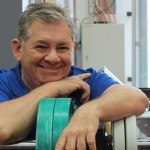If you have difficulty standing or walking, or feel unsteady on your feet, it needn’t mean exercise is out of the question. The British Heart Foundation have recently published some useful advice on chair-based exercise from Professor Patrick Doherty, Chair in Cardiovascular Health at The University of York, that you can try at home.
We all know that being physically active is good for us, but not everyone can take part in activities like walking, cycling or aerobics. If that’s the case for you, but you want to keep active, then chair-based exercise could be just what you’re looking for.
You can use these exercises if you have trouble getting up and about, or even if you just want a change of activity on days you can’t get outdoors. Don’t worry if you’ve not done much for a while – these seated exercises are gentle and easy to follow. However, if you have a health condition then it is essential that you check with your GP before you start. There are specific exercise programmes for people with a heart condition that your GP, cardiologist or cardiac rehab team can help you with.
Light and gentle
Chair-based exercise can be done at home or in small groups and easily fits your daily routine. It is a light and gentle form of exercise that will strengthen and lengthen your muscles, which may help take the strain out of everyday activities such as washing, dressing and shopping. Stronger muscles mean you are less likely to injure yourself doing routine tasks and will help with balance and walking. It stimulates the circulation and may even reduce instances of cramp.
Set realistic goals for yourself. For example, you could aim to do 10 to 20 minutes every other day for two weeks. Then, if you achieve that and don’t get too tired, you could plan to do more or carry on for a few more weeks and then reassess your goal. Wear loose, comfortable clothing and keep some water handy.
The six rules of chair-based exercise:
- Always use a strong chair, preferably with armrests and not too soft. When you sit in the chair, your thighs should be parallel with the floor.
- Keep your arm and leg movements steady, as this will help avoid muscle and joint strain. In the early stages, move your arms or legs one at a time. As you get more skilful, you can combine arm and leg movements in the same exercise. Ten to 12 repetitions per minute are normally enough, but you are the best judge of what you can manage.
- Warm up and cool down. When you start moving, the blood supply to the heart muscle needs a few minutes to reach optimal flow. Any combination of these exercises can be done gently to warm up or cool down, while you can do them more vigorously for the main part of your exercise session.
- Don’t exercise too hard. Aim for moderate-intensity exercise, which means you are slightly breathless and perhaps warmer than usual. Some days or weeks may be better than others, so adjust the intensity of the exercise to how you’re feeling.
- Never hold your breath while exercising. You’d be surprised just how often we forget to breathe when lifting our arms and legs or staying balanced.
- Keep your arm exercise below head height. This means the heart doesn’t have to pump so hard against gravity and will help to reduce breathlessness.
For more information please visit: www.bhf.org.uk/heart-matters-magazine/activity/chair-based-exercises or telephone the British Heart Foundation Customer Services on Tel: 0300 330 3322.
Here are a few easy exercises to get you started:
Alternate single arm across body with heel digs
Raise your right hand diagonally and touch your left shoulder. Simultaneously extend your left leg and plant your heel on the ground. Return your right hand to the arm of the chair and your left leg to a relaxed position. Repeat motion, this time using your left hand to touch your right shoulder, while extending your right leg.
Double arm forward with heel digs
Push your hands out slightly higher than your shoulder, in line with your chin, keeping your wrists extended. Only reach as far out as is comfortable for you. Coordination is important, so try to alternate which arm is in front of the other.
Double arm forward with heel digs
Push your hands out slightly higher than your shoulder, in line with your chin, keeping your wrists extended. Only reach as far out as is comfortable for you. Coordination is important, so try to alternate which arm is in front of the other.
Even a small amount of activity can be a tremendous boost to our wellbeing and help to tone and strengthen the body. So why not give it a go? You might be surprised at just how good it makes you feel.





